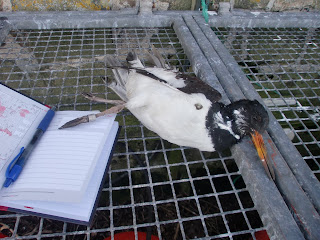 Baron and bleak - Inner Farne mid-January
Baron and bleak - Inner Farne mid-January Winter victim - Oystercatcher (ringed!) found dead on Inner Farne
Winter victim - Oystercatcher (ringed!) found dead on Inner FarneSaturday 22nd January comments:
The late January period brought a rest bite in the weather (and more importantly the sea state) allowing access to the islands. It was the first visit of 2011 and I suspect not the last but it was good to catch up with them, just to check for any storm damage and to see the general shape of the place. The islands can look very desolate at this time of year, with no breeding birds and a lack of any serious vegetation although it wasn’t as quiet as expected…
Good numbers of Guillemots were loafing about the waters with ‘several thousand’ on the cliff ledges of Staple Island. Its typical behaviour at this time of year as birds will come and go with fine weather during January-March but where still some way off the breeding season. As well as the Guillemots, Fulmars were present in reasonable numbers whilst Shag’s were already showing off their summer plumage crests. However it’s still early days and despite the flurry of activity, the islands remained quiet apart from the odd over-wintering Wren. On a sad note – I discovered a dead Oystercatcher on Inner Farne, a victim of the winter although the bird was bearing a ring so should bring some interesting data.
The only birds of real note were the wintering wildfowl on Knoxes Reef with a pair of Gadwall (a scarce visitor to the islands) with over 150 Mallards (this pair have been here since early November last year). Alongside this 61 Wigeon, 18 Teal and 12 Goldeneye which made up the reasonable haul of ducks.
I’ll hopefully return in the forthcoming weeks and will keep you posted.
Good numbers of Guillemots were loafing about the waters with ‘several thousand’ on the cliff ledges of Staple Island. Its typical behaviour at this time of year as birds will come and go with fine weather during January-March but where still some way off the breeding season. As well as the Guillemots, Fulmars were present in reasonable numbers whilst Shag’s were already showing off their summer plumage crests. However it’s still early days and despite the flurry of activity, the islands remained quiet apart from the odd over-wintering Wren. On a sad note – I discovered a dead Oystercatcher on Inner Farne, a victim of the winter although the bird was bearing a ring so should bring some interesting data.
The only birds of real note were the wintering wildfowl on Knoxes Reef with a pair of Gadwall (a scarce visitor to the islands) with over 150 Mallards (this pair have been here since early November last year). Alongside this 61 Wigeon, 18 Teal and 12 Goldeneye which made up the reasonable haul of ducks.
I’ll hopefully return in the forthcoming weeks and will keep you posted.



